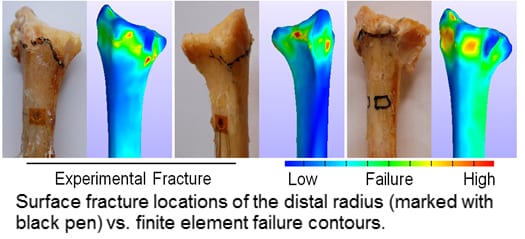Bone Adaptation in Healthy People
Healthy bone adapts to best resist its habitual mechanical loading environment. When the applied daily mechanical stimulus drops below some minimum threshold, bone loss occurs. Similarly, when the stimulus exceeds some threshold, bone will adapt to become stronger through a combination of increased bone mass and changes to bone geometry that are associated with increased mechanical strength. Our research uses experimental data, image analysis, and subject-specific computational models to accurately quantify:
- the mechanical stimulus applied to bone during specific activities
- three-dimensional changes to bone mass, density, and shape that occur over time
- the mechanical consequences of bone adaptation
We apply this basic toolset to a variety of clinical problems, as well as healthy situations. These include:
- Defining a quantitative input/output relationship between mechanical loading environment and bone adaptation in a healthy skeletal system
- Quantifying bone loss after acute spinal cord injury
- Evaluating treatment outcomes for interventions to improve bone health
Sub-projects related to bone adaptation
Mechanisms and prevention of distal radius fracture

Osteoporosis is a major health concern in the US that affects millions of Americans and costs billions of dollars each year. Prevention of osteoporotic fracture is the primary clinical goal for osteoporosis treatment. Distal radius fractures are common osteoporotic fractures associated with a fall onto an outstretched hand. In women, these fractures increase six-fold between the ages of 35 and 65. To better understand the mechanisms underlying distal radius fracture we have developed computational models based on clinical imaging data to predict bone strain and fracture strength under loading conditions simulating a fall. The modeling procedure was validated using experimental data from in vitro cadaveric testing. These models can be used to determine the most critical aspects of bone strength to help guide preventive measures aimed at reducing the occurrence of this injury.
An in-vivo human model of bone adaptation
Physical activity and exercise cause mechanical strain to occur within bone, thereby initiating an adaptive osteogenic response. Owing to this process, exercise during growth and young adulthood has been shown to increase peak bone mass and improve bone mechanical properties, providing life-long protection against osteoporosis. In animals, mechanical strain magnitude and strain rate are two key variables that are related to the degree of bone adaptation, with increasing osteogenic response occurring as each of these variables increases. Although the same mechanisms likely influence bone adaptation in humans, the manner in which this animal data may be translated has not been rigorously tested.
We know that a simple task – leaning onto the palm of the hand – can change the structure and strength of your bone. We are using this task to better understand the relationship between strain magnitude and strain rate to changes in distal radius bone structure and strength. We are currently recruiting female research subjects age 25-35! If you would like to learn more about participating, please email MBL@wpi.edu
People working on these projects:
Joshua E. Johnson, PhD
Tiffiny A. Butler, PhD
Karen Troy, PhD
Publications related to this project include:
Bhatia V.A., Edwards W.B., Johnson, J.E., Troy K.L. Short-Term Bone Formation is Greatest within High Strain Regions of the Human Distal Radius: a Prospective Pilot Study. J. Biomech. Eng., 2014 available online Oct 1. doi: 10.1115/1.4028847
